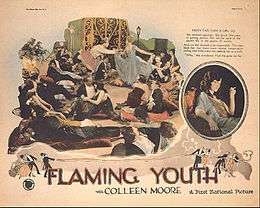Flaming Youth (film)
| Flaming Youth | |
|---|---|
 Lobby card | |
| Directed by | John Francis Dillon |
| Produced by | John McCormick |
| Written by | Harry O. Hoyt (scenario) |
| Based on |
Flaming Youth by Samuel Hopkins Adams |
| Starring |
Colleen Moore Milton Sills Elliott Dexter |
| Cinematography | James Van Trees |
| Distributed by | Associated First National |
Release dates |
|
Running time | 90 minutes |
| Country | United States |
| Language | Silent (English intertitles) |
Flaming Youth is a 1923 American silent drama film starring Colleen Moore and Milton Sills. The film was produced and distributed by Associated First National and directed by John Francis Dillon. Flaming Youth is based on the novel Flaming Youth by Samuel Hopkins Adams.
The film is now considered partially lost.[1] One reel survives and is housed at the Library of Congress.[2][3]
Plot
When Mona Frentiss dies, she has her confidante "Doctor Bobs" watch over her family, especially her youngest daughter Patricia. The family has been raised in a most unconventional manner, with Mona having a much younger lover and the father Ralph keeping his own lover on the side. As Patricia grows older, she attracts the attention of her mother's former lover, the much older (than Patricia, who in the book is in her early to mid teens) Carey Scott. Patricia tempts fate with her wild ways, nearly loses her virtue to a musician aboard an ocean-going boat, and is saved in time by Carey. Realizing that he is the man for her, she settles down into an experimental marriage.
Cast
- Colleen Moore as Patricia Frentiss
- Milton Sills as Cary Scott
- Elliott Dexter as Dr. Bobs
- Sylvia Breamer as Dee Fentriss
- Myrtle Stedman as Mona Fentriss
- Betty Francisco as Connie Fentriss
- Phillips Smalley as Ralph Fentriss
- Walter McGrail as Jamieson James
- Ben Lyon as Monty Standish
- George Barraud as Fred Browning
- John Patrick as Warren Graves
- Gino Corrado as Leno Stenak
- Gertrude Astor as Annie
- Michael Dark as Sidney Rathbone
Background
There had been several films prior to Flaming Youth which used the flapper as subject matter, most famously, The Flapper with Olive Thomas. However, Flaming Youth was the one that best captured the imagination of the American public, because it was based on a scandalous book and because it featured Colleen Moore, who was already a well-known and respected dramatic actress who had been looking for a break-out role at the time she signed with First National.
The film's marketing played up the racier aspects of the story, and a "skinny-dipping" sequence shot in silhouette (which still largely survives in the Library of Congress) was used in the films advertising extensively. The ads also boasted "neckers, petters, white kisses, red kisses, pleasure mad daughters, [and] sensation craving mothers."[4] The book contained adult subjects which were largely glossed over in the film. To counter potential negative backlash, a good deal of humor was injected into the film, so that many audiences thought the film was actually a burlesque of the whole flapper movement when, in fact, it was intended to be a dramatic film.[5]
The reaction to the film was enthusiastic, and it firmly fixed in the public's imagination a new kind of female behavior.[4] According to F. Scott Fitzgerald: "I was the spark that lit up Flaming Youth, Colleen Moore was the torch."[4]

See also
References
- ↑ Flaming Youth at TheGreatStars.com; Lost Films Wanted
- ↑ Flaming Youth at silentera.com database
- ↑ American Silent Feature Film Survival Database Flaming Youth
- 1 2 3 Savage, Jon. Teenage: The Creation of Youth Culture. New York: Viking, 2007. ISBN 978-0670038374, p.205
- ↑ Gebhart, Myrtel. Los Angeles Times (May 18, 1924)